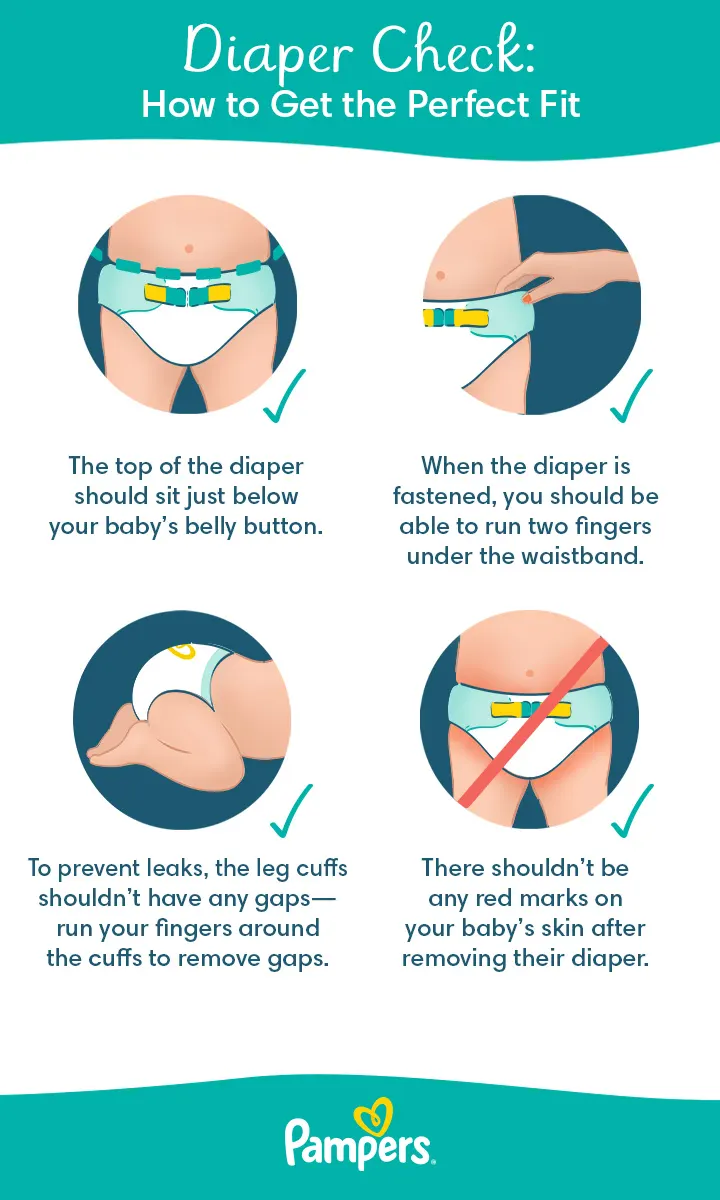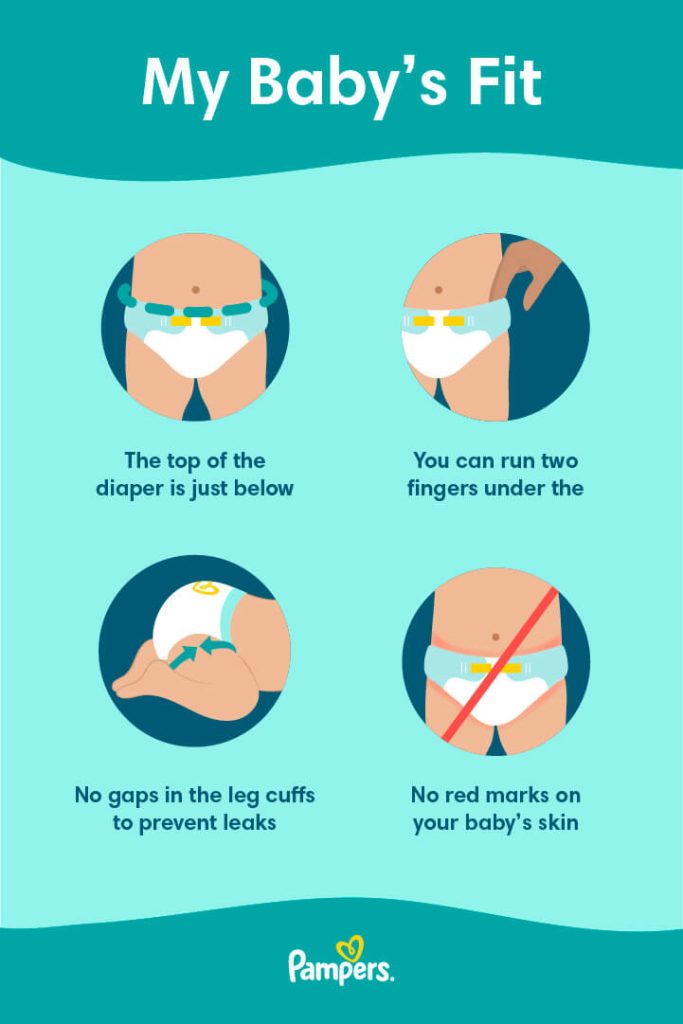**Answer:** Signs include red marks on the baby’s thighs or waist and frequent leaks or blowouts. The diaper may also be difficult to fasten.
**** Choosing the right diaper size is crucial for your baby’s comfort and health. Too-small diapers can cause irritation, discomfort, and leaks. Properly fitting diapers ensure your baby stays dry and happy throughout the day. Understanding the signs that a diaper is too small can help you make timely adjustments.
This guide provides clear indicators to watch for, ensuring your baby remains comfortable and well-protected. Regularly checking the fit and making necessary changes can prevent potential skin issues and keep your baby content. Stay alert to these signs to maintain your baby’s well-being.
Signs Of Tightness
Identifying the right diaper size is crucial for your baby’s comfort. A diaper too small can cause discomfort and even health issues. Look for signs of tightness to determine if the diaper fits properly.
Red Marks On Skin
Red marks on your baby’s skin are a clear sign. These marks are usually found around the waist and thighs. Red marks indicate the diaper is too tight and causing irritation. This can make your baby uncomfortable and fussy.
Inspect the skin every time you change the diaper. If you notice red marks, consider switching to a larger size.
Indentations Around Waist
Indentations around the waist are another sign. These indentations are visible lines on the skin. They can appear after you remove the diaper. Indentations suggest the diaper is pressing too hard on the skin. This can restrict movement and cause pain.
To avoid this, ensure the diaper is snug but not tight. You should be able to slide a finger between the diaper and the skin comfortably.

Credit: kitandkin.com
Frequent Leaks
Parents, are you noticing frequent leaks with your baby’s diaper? This could be a sign the diaper is too small. A poorly fitting diaper often results in leakage. This not only causes discomfort for your baby but also extra laundry for you.
Wet Clothes
If your baby’s clothes are often wet, the diaper might be too small. A snug diaper can’t hold in wetness effectively. You may notice wet patches around the legs and waist. This means the diaper isn’t providing the necessary coverage.
| Signs | Description |
|---|---|
| Wet Patches | Visible wet areas around legs and waist. |
| Frequent Changes | Needing to change clothes multiple times a day. |
| Uncomfortable Baby | Baby appears fussy and uncomfortable. |
Bedtime Accidents
Bedtime accidents are another clue. If your baby wakes up wet, the diaper may be too tight. Tight diapers can’t absorb a full night’s worth of wetness. This leads to interrupted sleep for both you and your baby.
Consider checking for the following signs:
- Baby wakes up crying due to wetness.
- Diaper feels heavy and wet in the morning.
- Baby’s bedding is often damp.
Ensuring the right diaper size is key for a dry and happy baby.
Discomfort Indicators
Babies can’t tell us their diapers are too small. We must look for signs. Discomfort indicators help us understand their needs better. Recognizing these signs early can prevent rashes and discomfort.
Fussiness During Changes
Fussiness during diaper changes is a key sign. Babies usually fuss for various reasons. But if they cry more during changes, the diaper might be too tight. Check the baby’s skin for red marks.
Red marks around the waist and thighs suggest tightness. If the diaper leaves imprints, it’s too small. Switching to a larger size can help the baby feel more comfortable.
Difficulty Moving
Another indicator is difficulty moving. Babies need freedom to move their legs. A too-small diaper restricts movement. Observe if the baby struggles to kick or crawl.
This can be a clear sign the diaper is too tight. Ensure the diaper allows for easy movement. A properly fitting diaper should not limit the baby’s natural movements.
Inadequate Coverage
A properly fitting diaper is crucial for your baby’s comfort and hygiene. Inadequate coverage is a common sign that the diaper might be too small. If the diaper does not cover your baby’s bottom fully, it can lead to leaks and discomfort.
Exposed Buttocks
If your baby’s buttocks are exposed, the diaper is too small. Proper coverage is necessary to prevent leaks. Check the waistband; it should sit above the hips. If it sits lower, you need a larger diaper size.
Gaps Around Legs
Gaps around the legs are another sign of a small diaper. A well-fitted diaper should snugly encircle your baby’s legs. Gaps can lead to leaks and discomfort. Ensure the leg cuffs sit properly around the thighs without gaps.
| Signs | Description |
|---|---|
| Exposed Buttocks | The diaper does not cover the baby’s bottom fully. |
| Gaps Around Legs | There are visible gaps around the baby’s thighs. |
- Check the waistband position.
- Ensure the leg cuffs fit snugly.
- Look for leaks and discomfort.
- Inspect the diaper after every change.
- Adjust the size if signs of inadequate coverage appear.
- Choose a larger size for better coverage.
Fasteners Issues
Diaper fasteners should fit snugly around your baby’s waist. They should not cause discomfort. If you notice problems with the fasteners, the diaper may be too small. Here’s how to tell:
Tabs Not Reaching
Check the diaper tabs when fastening. Diaper tabs should reach the front panel without struggle. If the tabs barely reach or fail to attach, the diaper is too small.
| Indicator | Description |
|---|---|
| Tabs barely reach | The tabs do not cover enough area. |
| Tabs fail to attach | The tabs do not stick or hold. |
Strain On Fasteners
Look for signs of strain on the fasteners. Strain means the fasteners are pulling too tight. This can lead to discomfort and leaks.
- Red marks on the waist
- Visible stretching or tearing of the fasteners
- Diaper edges digging into the skin
If any of these signs are present, consider moving to a larger diaper size. Your baby will be more comfortable and better protected.
Visible Size Label
Knowing whether a baby diaper is too small is crucial for your baby’s comfort. One key sign is the visible size label. This section will help you understand this indicator better.
Label Appearing Outside
If you see the size label peeking outside the diaper, it may be too small. Diapers should fit snugly but not be tight. When the size label is visible, it suggests that the diaper is stretched too much. This can cause discomfort and leaks.
Check if the diaper label is visible when your baby moves. If it is, consider switching to the next size. This will ensure a better fit and more comfort for your little one.
Stretched Material
Another sign of a small diaper is stretched material. Look at the waistband and leg cuffs. If they appear overstretched, the diaper is too small. Overstretched material can irritate your baby’s skin. It can also lead to leaks.
Run your fingers along the diaper edges. If you feel tightness, it’s time for a bigger size. A properly fitting diaper should have some give without being loose. This helps in preventing rashes and keeps your baby happy.
Remember, a comfortable baby is a happy baby. Always check for these signs to ensure the right diaper size.
| Signs | What to Look For |
|---|---|
| Visible Size Label | Label peeking outside the diaper |
| Stretched Material | Overstretched waistband and leg cuffs |
Diaper Rash
Diaper rash is a common issue for babies. It can cause discomfort and worry for parents. Knowing if a diaper is too small can help prevent rashes.
Frequent Rashes
Frequent rashes can be a sign of a too-small diaper. A tight diaper can trap moisture against your baby’s skin. This creates a perfect environment for rashes.
Keep an eye on the frequency of rashes. If rashes appear often, the diaper size might be too small.
| Signs of Frequent Rashes |
|---|
| Red patches on the skin |
| Small bumps or pimples |
| Peeling or flaking skin |
| Baby seems uncomfortable |
Irritation In Diaper Area
Irritation in the diaper area is another clue. A too-small diaper can cause chafing. This leads to irritation and redness.
Check for signs of irritation regularly. Look for red marks around the legs and waist. These marks mean the diaper is too tight.
- Redness around the diaper edges
- Baby crying during diaper changes
- Visible marks on the skin
Switching to a larger diaper can reduce irritation. Ensure the diaper fits comfortably and is not too snug.

Credit: www.pampers.ca
Choosing The Right Size
Choosing the right size diaper for your baby is crucial. An ill-fitting diaper can cause discomfort and leaks. Let’s explore how to ensure your baby’s diaper fits perfectly.
Weight Guidelines
Diaper sizes often depend on your baby’s weight. Here’s a simple guide:
| Diaper Size | Baby Weight |
|---|---|
| Newborn | Up to 10 lbs |
| Size 1 | 8-14 lbs |
| Size 2 | 12-18 lbs |
| Size 3 | 16-28 lbs |
| Size 4 | 22-37 lbs |
| Size 5 | 27+ lbs |
Brand Size Variations
Diaper sizes can vary by brand. Always check the packaging for weight guidelines. Some brands may run smaller or larger.
Here are tips to help:
- Compare brands: Look at the size chart for each brand.
- Test fit: Try a small pack first to check the fit.
- Read reviews: Other parents’ experiences can guide your choice.
Remember, a good fit means fewer leaks and a happier baby.

Credit: community.whattoexpect.com
Frequently Asked Questions
How Can You Tell If A Diaper Is Too Small?
If the diaper leaves red marks on baby’s skin, it’s too small. Also, frequent leaks are a sign. Check if the diaper fits snugly without gaps.
What Are Signs Of A Tight Diaper?
Red marks, indentations, and difficulty fastening are signs of a tight diaper. Also, if baby seems uncomfortable, it might be too tight.
Do Small Diapers Cause Leaks?
Yes, small diapers can cause leaks. They can’t contain waste properly. Ensure the diaper fits well around the legs and waist.
How Often Should I Check Diaper Size?
Check diaper size every few weeks. Babies grow quickly. Regular checks prevent discomfort and leaks from an ill-fitting diaper.
Conclusion
Knowing when a baby diaper is too small ensures your baby’s comfort and health. Check for red marks, leaks, and snugness. Always prioritize your baby’s needs and switch sizes when necessary. Proper diaper fit prevents discomfort and keeps your baby happy and healthy.
Stay attentive to your baby’s signals for the best care.




